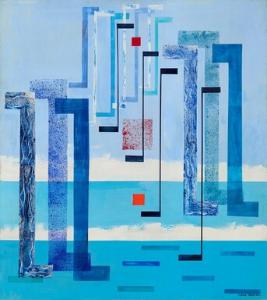Irene Rice Pereira
Irene Rice;Irene Rice Pereira
Place: Chelsea
Born: 1902
Death: 1971
Biography:
Irene Rice Pereira (August 5, 1902 – January 11, 1971) was an American abstract artist, poet and philosopher who played a major role in the development of modernism in the United States. She is known for her work in the genres of geometric abstraction, abstract expressionism and lyrical abstraction, as well as her use of the principles of the Bauhaus school. Her paintings and writings were significantly influenced by the complex intellectual currents of the 20th century. Pereira was born Irene Rice on August 5, 1902 in Chelsea, Massachusetts, a suburb of Boston, the eldest of three sisters and one brother. She spent her childhood in Great Barrington, Massachusetts, where she spent time reading and writing poetry. After her father died in 1918 she and her family moved to Brooklyn, New York. In 1922 she began working as a stenographer in an accountant's office to help support her family in the wake of her father's death. She briefly attended courses in fashion design at the Traphagen School of Fashion and night courses in literature at New York University, and began taking evening art classes at Manhattan's Washington Irving High School. She immersed herself in the bohemian world of Greenwich Village and had a brief affair with the poet and novelist Maxwell Bodenheim. In 1927, she enrolled in night art classes at the Art Students League in New York City. Among her instructors at the Art Students League were Jan Matulka and Richard Lahey. In her 1929 class Matulka provided Pereira with her first exposure to the artistic principles of the European avant-garde that would shape her work; most notably those of the Bauhaus, Cubism, and Constructivism (art). In 1931, she traveled to Europe and North Africa to further her painting studies, attending sessions at the Académie Moderne and studying with Amédée Ozenfant in Paris. She also spent time in Switzerland and Italy. After returning to New York in 1933 she studied briefly with Hans Hofmann at the Art Students League. Her friends and colleagues were Burgoyne Diller, Dorothy Dehner, David Smith, Hilla Rebay, Arshile Gorky, John D. Graham, and Frederick Kiesler. In 1935, Pereira helped found the Design Laboratory, a cooperative school of industrial design established under the auspices of the Works Progress Administration. The curriculum of the Design Laboratory was similar to that of the Bauhaus. All students were required to take a basic course that included an introduction to chemistry, physics, and art materials. Students experimented with materials in laboratories in order to understand their physical properties. There was an emphasis on social considerations, and students were taught the social implications of technological developments alongside classes in art, music, and literature. Pereira taught classes in painting, composition, and design synthesis. She continued teaching at the Design Laboratory when it lost its financial support from the Works Progress Administration on June 27 of 1937. On July 1, 1937 the Design Laboratory became part of the FAECT School, located at 114 E. 16th St. New York. When classes resumed on September 27 of 1937 the school was known as The Laboratory School of Industrial Design. She resigned her position in October 1939. Pereira painted throughout her life. Her paintings first gained recognition in the early 1930s, when she exhibited at the ACA Galleries and the Whitney Museum of American Art in New York. With the showcase at the Whitney, she became one of the first women (along with Loren MacIver and Georgia O'Keeffe) to be given a retrospective at a major New York museum. In the late 1930s, she started to move away from realistic work toward abstraction and experimented with painting on glass and other non-traditional materials. She also began to incorporate text and other non-traditional elements into her work. In the 1940s, she became associated with the abstract expressionist movement and began to incorporate elements of surrealism into her work. She also began to experiment with collage and other mixed media techniques. In the 1950s, she began to incorporate elements of calligraphy and other forms of writing into her work. She also began to experiment with different forms of painting, including monochromatic paintings and paintings that incorporated different forms of light. In the 1960s, she began to incorporate elements of Eastern spirituality into her work. She also began to experiment with different forms of sculpture, including bronze sculptures and sculptures made from other materials. She continued to paint and exhibit her work until her death in 1971.



